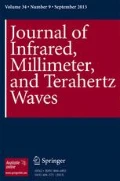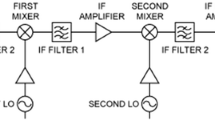Abstract
This paper analyzes different input-matching mechanisms used in designing the wide-band amplifiers in general, and the low noise amplifiers (LNA) in particular, and their corresponding noise impact. Among them, the most promising one is the reactive-feedback circuit configuration, which is a combination of high-frequency inductive feedback and low frequency capacitive feedback. In this paper the simulated result that both matched input impedance and low noise temperature T n can be achieved simultaneously over a wide bandwidth in the single-ended low noise amplifier is proved mathematically and is well interpreted. This understanding of reactive feedback is crucial for the future development of ultra-wide-band low-noise amplifiers.
Similar content being viewed by others
References
[1] C.C. Chin, et al, “A low-noise 100 GHz sideband separating receiver,” Intl. J. IR & MM Waves, vol. 24, pp. 569–600, April 2004.
[2] R. Rice, M. Sumner, J. Zmuidzinas, R. Hu, H.G. Leduc, A.I. Harris, D. Miller, “SIS mixer design for a broadband millimeter spectrometer suitable for rapid line surveys and redshift determinations,” Proc. SPIE, vol. 4855, pp. 301–311, Feb. 2003.
[3] J. Yang, S. Huang, M. Ohishi, K. Miyazawa, R. Henneberger, “A 492 GHz submillimeterwave receiver,” Intl. J. IR & MM Waves, vol. 22, pp. 217–223, Feb. 2001.
[4] I.L. Fernandiz, J.D. Gallego, C. Diez, A. Barcia, J.M. Pintado, “Wide-band ultra low noise cryogenic InP IF amplifiers for the Herschel mission radiometers,” Proc. SPIE, vol. 4855, pp. 489–500, Feb. 2003.
[5] N. Wadefalk, et al., “Cryogenic Wide-Band Ultra-Low-Noise IF Amplifiers Operating at Ultra-Low DC Power,” IEEE Trans. Microwave Theory Tech., vol. 51, pp. 1705–1711, June 2003.
[6] S. Weinreb, D. L. Fenstermacher, R. W. Harris, “Ultra-low-noise 1.2- to 1.7-GHz cooled GaAsFET amplifiers,” IEEE Trans. Microwave Theory Tech., vol. 82, pp. 849–853, June 1982.
[7] R. Hu, “An 8–20 GHz LNA design and the analysis of its input matching mechanism,” IEEE Microwave and Wireless Components Letter, vol. 14, pp. 528–530, Nov. 2004.
[8] T.K. Nguyen, C.H. Kim, G.J. Ihm, M.S. Yang, S.G. Lee, “CM OS low-noise amplifier design optimization techniques,” IEEE Trans. Microwave Theory Tech., vol. 52, pp. 1433–1442, May 2004.
[9] D. Lu, D. Rutledge, M. Kovacevic, J. Hacker, “A 24-GHz patch array with a power amplifier/low-noise amplifier MMIC,” Intl J. IR & M Waves, vol. 23, pp. 693–704, May 2002.
[10] G. Gonzalez, “Microwave transistor amplifier: analysis and design,” Prentice-Hall Inc. ISBN 0135816467, 1984.
[11] R. Hu, S. Weinreb, “A novel wide-band noise-parameter measurement method and its cryogenic application,” IEEE Trans. Microwave Theory Tech., vol. 52, pp. 1498–1507, May 2004.
[12] R. A. Minasian, “Simplified GaAs MESFET model to 10 GHz,” Electronic letter, pp. 549–551, Sep. 1977.
[13] M. Berroth, R. Bosch, “Broad-band determination of the FET small-signal equivalent circuit,” IEEE Trans. Microwave Theory Tech., vol. 38, pp. 891–895, July 1990.
[14] G. Dambrine, A. Cappy, F. Heliodore, E. Playez, “A new method for determining the FET small-signal equivalent circuit,” IEEE Trans. Microwave Theory Tech., vol. 36, pp. 1151–1159, July 1988.
[15] A. Eskandarian, S. Weinreb, “A note on experimental determination of small-signal equivalent circuit of millimeter-wave FETs,” IEEE Trans. Microwave Theory Tech., vol. 41, pp. 159–162, Jan. 1993.
[16] M. W. Pospieszalski, “Modeling of noise parameters of MESFET’s and MODFET’s and their frequency and temperature dependence,” IEEE Trans. Microwave Theory Tech., vol. 37, pp. 1340–1350, Sep. 1989.
[17] F. Danneville, H. Happy, G. Dambrine, J. M. Belquin, A. Cappy, “Microscopic noise modeling and macroscopic noise modeling: How good a connection,” IEEE Trans. Microwave Theory Tech., vol. 42, pp. 779–786, May 1994.
[18] J. H. Han, K. Lee, “A new extraction method for noise sources and correlation coefficient in MESFET,” IEEE Trans. Microwave Theory Tech., vol. 44, pp. 487–490, Mar. 1996.
[19] K. B. Niclas, W. T. Wilser, R. B. Gold, W. R. Hitchens, “The matched feedback amplifier: ultra-band microwave amplification with GaAs MESFET’s,” IEEE Trans. Microwave Theory Tech., vol. 28, pp. 285–294, April 1980.
Author information
Authors and Affiliations
Rights and permissions
About this article
Cite this article
Hu, R., Yang, M. Investigation of Different Input-Matching Mechanisms Used in Wide-Band LNA Design. Int J Infrared Milli Waves 26, 221–245 (2005). https://doi.org/10.1007/s10762-005-3002-4
Received:
Published:
Issue Date:
DOI: https://doi.org/10.1007/s10762-005-3002-4




